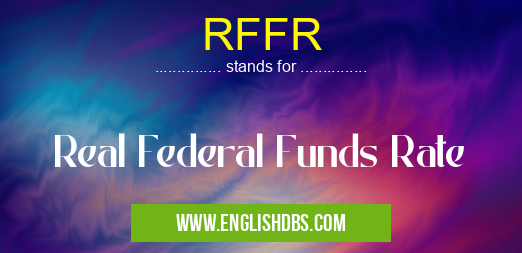What does RFFR mean in FUNDS
RFFR stands for Real Federal Funds Rate. It represents the interest rate at which commercial banks and other depository institutions lend reserve balances to each other overnight on an uncollateralized basis. The RFFR is a key indicator of monetary policy set by the Federal Reserve (Fed).

RFFR meaning in Funds in Business
RFFR mostly used in an acronym Funds in Category Business that means Real Federal Funds Rate
Shorthand: RFFR,
Full Form: Real Federal Funds Rate
For more information of "Real Federal Funds Rate", see the section below.
Understanding the RFFR
The RFFR plays a crucial role in the financial system by:
- Influencing short-term interest rates: It serves as a benchmark for other short-term interest rates, such as the prime rate and the LIBOR (London Interbank Offered Rate).
- Managing inflation: By adjusting the RFFR, the Fed can influence inflation by making borrowing more or less expensive.
- Stimulating economic growth: Lowering the RFFR can stimulate economic growth by encouraging businesses and consumers to borrow and invest.
Setting the RFFR
The Fed sets the RFFR through open market operations, where it buys and sells government securities. When the Fed purchases securities, it injects money into the financial system, which tends to lower the RFFR. Conversely, when the Fed sells securities, it withdraws money from the system, which can increase the RFFR.
Importance of the RFFR
The RFFR is a key indicator of the Fed's monetary policy stance and has a significant impact on:
- Financial markets: It influences the pricing of financial instruments, such as bonds and stocks.
- Economic activity: It affects investment, consumption, and employment levels.
- Inflation expectations: Changes in the RFFR can shape market expectations about future inflation.
Essential Questions and Answers on Real Federal Funds Rate in "BUSINESS»FUNDS"
What is the Real Federal Funds Rate (RFFR)?
The Real Federal Funds Rate (RFFR) is a measure of the short-term interest rate in the economy, adjusted for inflation. It is the nominal federal funds rate minus the current inflation rate, as measured by the Consumer Price Index (CPI).
How is the RFFR calculated?
The RFFR is calculated by subtracting the current inflation rate from the nominal federal funds rate. For example, if the nominal federal funds rate is 2% and the current inflation rate is 1%, then the RFFR would be 1%.
What is the significance of the RFFR?
The RFFR is an important indicator of the stance of monetary policy. A positive RFFR indicates that the central bank is pursuing a contractionary monetary policy, while a negative RFFR indicates that the central bank is pursuing an expansionary monetary policy.
How does the RFFR affect the economy?
A positive RFFR makes it more expensive for businesses to borrow money, which can slow down economic growth. A negative RFFR makes it less expensive for businesses to borrow money, which can stimulate economic growth.
What factors influence the RFFR?
The RFFR is influenced by a number of factors, including the economic outlook, inflation expectations, and the actions of the central bank.
Final Words: The Real Federal Funds Rate (RFFR) is a crucial interest rate that plays a pivotal role in the financial system and economic policy. By adjusting the RFFR, the Fed manages short-term interest rates, influences inflation, and stimulates or cools economic growth. Understanding the RFFR is essential for investors, businesses, and policymakers alike to navigate the complexities of monetary policy.
RFFR also stands for: |
|
| All stands for RFFR |
